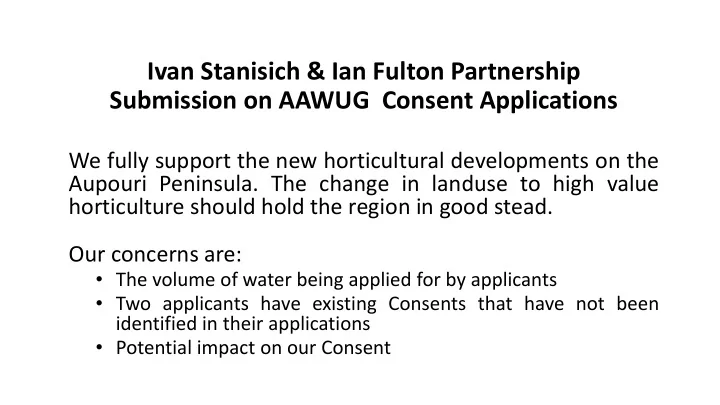

Ivan Stanisich & Ian Fulton Partnership Submission on AAWUG Consent Applications We fully support the new horticultural developments on the Aupouri Peninsula. The change in landuse to high value horticulture should hold the region in good stead. Our concerns are: • The volume of water being applied for by applicants • Two applicants have existing Consents that have not been identified in their applications • Potential impact on our Consent
Volume of water being applied for by applicants Two components that determine volume of water being applied for by applicants: Canopy area; and • Water required by crop (mainly avocados) • Canopy Area Unlike kiwifruit industry, there is no industry standard to calculate • canopy area for avocados Most applicants using all land suitable for orcharding as canopy area • However, some applicants are using area trees occupy as canopy area •
Figure 1 Figure 2
Water Requirements for Avocados Water use models – about 4,000 m 3 / canopy ha per annum • MWWUG decision – 3,920 m 3 /canopy ha per annum • Benchmarked fully developed productive orchards actual water use in 2019/2020 vs modeled and MWWUG decision Production ranged from 14 to 26 tonnes per canopy ha • Two orchards NZ Avocado award for highest most consistent production • Water use for 2019/2020 Orchard area ha - ranged from 844 to 2,522 m 3 per ha • Canopy area ha – ranged from 1,160 to 3,142 m 3 per ha •
Volume Used 2019/2020 (m 3 year) Canopy Canopy % Consent Orchard Type of Canopy % Consent No. Area Orchard Volume Orchard Area Canopy Area Area (ha) Orchard young trees Total (m 3 year) (ha) Area per ha per ha AUT.017559.02.01 105,000 44,249 20.9 15.8 75% High density 5% 2,117 2,801 AUT.029171.01.01 24,000 0 AUT.015147.01.03 22.0 16.5 75% Conventional 15% 98,000 36,340 1,652 2,202 AUT.008340.01.04 35.0 26.8 77% Conventional 20% 158,520 68,078 1,945 2,540 AUT.029109.01.02 6.6 4.5 68% Conventional 0% 20,000 6,130 929 1,362 AUT.023557.01.02 17.6 12.8 73% Conventional 10% 46,000 14,849 844 1,160 AUT.017045.01.02 135.0 110.0 81% High density 0% 558,000 345,574 2,522 3,142 AUT.007108.01.02 6.9 5.2 75% Conventional 10% 16,740 7,739 1,122 1,488 AUT.003968.01.03 11.5 8.5 73% Conventional 0% 25,000 11,310 983 1,331
Discussion No orchard came close to the 3,920 m 3 /ha/yr recommended allocation. This indicates the MWWUG recommendations and various water use models results are setting allocations too high. Avocado crop coefficient for NZ summer (irrigation season): Mature trees – 0.45 to 0.60 (9yr old conventional spacing) • Young trees – 0.25 to 0.30 (3yr old conventional spacing) • Mature high density plantings will have crop coefficient on the lower end of the range of mature trees. Orchards benchmarked – orchard area 256ha, canopy area 200ha plus 20 to 25ha undeveloped – 2019/2020 drought only used 53% of water allocation
Conclusion Definition of canopy area needs to be clearly defined For a 1 in 10-year drought, water allocation should be no more than: • Orchard area – 2,500 m 3 per ha per year • Canopy area (irrigated area) – 3,200 m 3 per ha per year Nearly all existing consents have water allocations that are far too high. Council needs a mechanism or review process to reduce consent allocations if they are not being utilized, thereby freeing up water resources for further development in the Far North.
Legal Opinion To Strike Out Part Of Our Submission s41D(1)(b) - … “fall within the ambit of a land use consent application” Submission was related to proposed ISP consent requirement Pointing out after develop soils are highly disturbed and some cases • become an anthropic (man made) soil Rooting depth between rows that are not pan broken can be shallow • Soil texture varies from sand through to peaty loam • An ISP should include proper soil physical characterisation. Has little impact on annual water allocation, but does effect irrigation scheduling and application volume / rate.
Valic NZ Ltd (King Avocado) - APP.040362.01.01 Existing consent – 558,000 m 3 /yr Property area – 159.9 ha Water used 2019/2020 – 345,574 m 3 Orchard area – approx. 135 ha Consent application – 173,700 m 3 /yr Canopy area – approx. 110 ha Undeveloped area – approx. 15 ha Question: Where is the justification for this consent application - Valic have an existing consent for 558,000 m 3 /yr and only used 345,574 m 3 over the 2019-2020 drought. Only about 15 ha of land is undeveloped on the property, so there is ample water available in their existing consent.
Current Proposed
Wataview Orchards – APP.040363.01.01 Existing consent - 50,000 m 3 /yr Property area – 22.1 ha Orchard area – approx. 14.8 ha Consent application - 33,750 m 3 /yr Canopy area – approx. 12.0 ha Protected vegetation – 3.4 ha Steep sidings – approx. 3.9 ha Question: Where is the justification for this consent application and why has the existing consent not been identified.
Potential impact on our Consent Consent - 60,000 m 3 /yr Property area – 37 ha 1,875 m 3 per orchard area ha Orchard area – 32 ha • 2,500 m 3 per canopy area ha Canopy area – 24 ha • In a year like 2019/2020 severe drought we expect to use all our consent allocation. Our major concern is if the Aupouri aquifer becomes over allocated, the Northland Regional Council will simply just cut every consent by a given percentage amount. Should this occur our orchard would be severely compromised, while over allocated orchards would not be impacted.
Recommend
More recommend